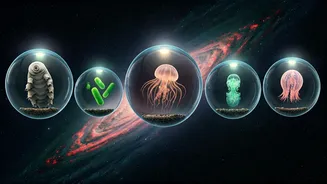Microscopic Marvels
Tardigrades, often called water bears or moss piglets, are the champions of extreme survival. These minuscule invertebrates can endure a wide range of hostile
environments. They can withstand temperatures from just above absolute zero to well above boiling, survive intense radiation exposure, and persist in the vacuum of space. Tardigrades achieve this through a process called cryptobiosis, essentially putting themselves in a state of suspended animation. During cryptobiosis, they can dehydrate, retract their limbs, and drastically slow their metabolism, allowing them to endure conditions that would obliterate other life forms. Experiments in space have demonstrated tardigrades’ ability to withstand the vacuum, radiation, and extreme temperature fluctuations, making them a prime example of life's remarkable adaptability.
Radiant Bacteria's Resilience
Deinococcus radiodurans, often referred to as 'Conan the Bacterium,' is another survival superstar. This bacterium can withstand radiation doses thousands of times higher than those lethal to humans. Its extraordinary resistance stems from its ability to rapidly repair DNA damage. Even when its genetic material is shattered into fragments, D. radiodurans can reassemble it efficiently. This unique capability is due to multiple copies of its genome and efficient DNA repair mechanisms. Scientists have studied Deinococcus radiodurans to understand how organisms can survive in extreme environments. Its resilience makes it a valuable subject for research on radiation resistance and the limits of life.
The Resilient Extremophiles
Extremophiles are a diverse group of organisms that thrive in extreme environments. They include a variety of bacteria, archaea, and even some eukaryotes. Many extremophiles are adapted to conditions that would be fatal to most life forms, such as high temperatures, high pressure, high salinity, or extreme acidity. Some extremophiles can even survive in conditions mimicking those of outer space. These organisms showcase the incredible diversity of life and its ability to adapt and persist in environments considered uninhabitable. The study of extremophiles offers insights into the potential for life beyond Earth and the limits of biological endurance.
The Enduring Nematodes
Nematodes, also known as roundworms, are another group of organisms with impressive survival abilities. These microscopic worms can enter a state of suspended animation, similar to tardigrades, to survive harsh conditions. Scientists have revived nematodes frozen in permafrost for tens of thousands of years, demonstrating their remarkable resilience. These worms can also withstand extreme radiation and desiccation. The ability to enter cryptobiosis allows them to persist through prolonged periods of environmental stress. Studying nematodes helps researchers understand mechanisms of aging, stress resistance, and the potential for life to survive over extremely long timescales.
Archaea's Robustness
Archaea, a domain of single-celled microorganisms, are known for their ability to thrive in extreme environments. Many archaea are extremophiles, with adaptations allowing them to live in conditions of high temperature, salinity, or acidity. Some archaea can survive in conditions that mimic the vacuum of space, highlighting their extraordinary resilience. These microorganisms have unique cell structures and metabolic processes that allow them to endure conditions unsuitable for most life forms. Their study provides insights into the potential for life in extreme environments on Earth and beyond, suggesting possibilities for life in environments previously thought impossible.















